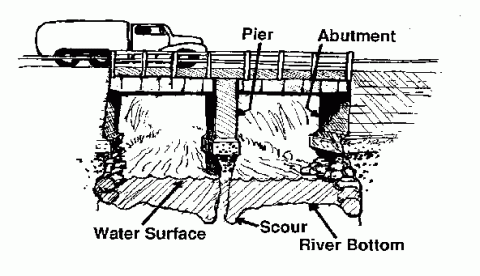Tennessee in Motion is a monthly column by Tennessee Department of Transportation Commissioner Gerald Nicely

As heavy rains fall on Tennessee, TDOT’s bridge inspectors await notifications from an automated program called “Bridge Watch.” Flooding can undermine the structural integrity of certain bridges in the state, so TDOT utilizes this program to alert the department of any potential problems with bridges due to heavy rains.
The most common cause of bridge failure is the undermining of a bridge structure because of scour. Scour is the erosion of a stream or river bed due to excessive stream flow. TDOT has classified 897 bridges in Tennessee as scour-critical, which means bridges could experience a catastrophic failure or become structurally unstable as a result of a destructive flood event.
TDOT’s “Bridge Watch” program monitors weather events through the National Weather Service and rates them based on the possible severity of flooding that could result from a rain event. The program then continually monitors weather mapping, weather radar, and stream gauges from the internet, and compares the information to a map of designated bridges in the state. It then predicts which bridges might be affected by potential flooding.

State bridge inspectors are notified via text message, e-mail, and fax to check structures that are experiencing or could experience high water conditions. TDOT bridge inspectors visit these structures to check the bridges for any added substructure exposure (scour), continued structural stability and alignment, and streambed movement. Photos are occasionally taken of the conditions that are present at the time of the alert.
The “Bridge Watch” program is then updated to show that the bridge was inspected and the photos of the structure are attached to maintain a record of the event for future use.
Once the rains have passed, a follow up inspection is completed to ensure no permanent damage was done to the substructure. If there is evidence of bank or sediment removal from under the bridge, measurements are taken of the streambed and compared to notes taken from previous stream profiles to see how much material was lost. If any damage is found immediate action is taken to repair the areas that are damaged so that the bridge will remain safe for travelers.
During the recent heavy rains and flooding in Tennessee, bridge inspection crews in the Chattanooga, southern middle Tennessee and west Tennessee regions responded to a number of scour alerts and in one instance in west Tennessee, closed a bridge and initiated a number of repairs to ensure the bridge remained safe for traffic.
The “Bridge Watch” program is just one part of a larger overall inspection and review process that ensures the bridges in our state are safe for motorists. Tennessee is consistently recognized for having one of the best bridge inspection programs in the nation and this program is certainly one of the reasons.
About Gerald Nicely
 Gerald Nicely is the Commissioner of Transportation for the State of Tennessee. He serves on the Board the American Association of State Highway and Transportation Officials. He was a Founding Board member of the Frist Center for the Visual Arts and a Charter Board member of the Nashville Housing Fund. He is an alumnus of Leadership Nashville. Nicely has received numerous awards for public service including: Tennessee Association of Public Administration’s Public Administrator of the Year in 2006, the Nashville Kiwanis Club’s co-Nashvillian of the year in 2001 (his wife Donna was the co-recipient), the Nashville Chapter of the American Public Relations Society’s Apollo award in 2006 and the Nashville Engineering Center’s Distinguished Builder Award.
Gerald Nicely is the Commissioner of Transportation for the State of Tennessee. He serves on the Board the American Association of State Highway and Transportation Officials. He was a Founding Board member of the Frist Center for the Visual Arts and a Charter Board member of the Nashville Housing Fund. He is an alumnus of Leadership Nashville. Nicely has received numerous awards for public service including: Tennessee Association of Public Administration’s Public Administrator of the Year in 2006, the Nashville Kiwanis Club’s co-Nashvillian of the year in 2001 (his wife Donna was the co-recipient), the Nashville Chapter of the American Public Relations Society’s Apollo award in 2006 and the Nashville Engineering Center’s Distinguished Builder Award.


